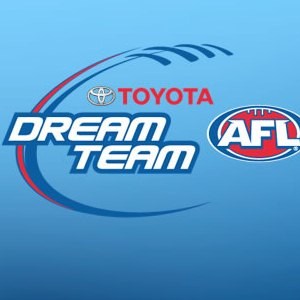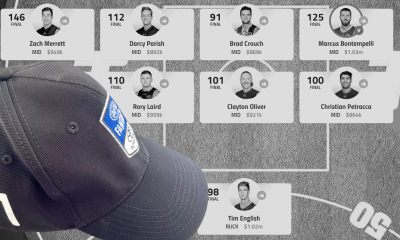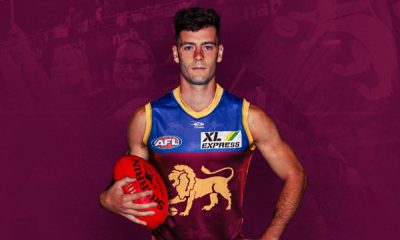 Virtual Sports have finally released the annual tweaks to SuperCoach – and we have some big ones. If we make the logical assumption that DT will be identical to SC, then we now know what to expect in season 2013! Without too much changing structurally in the AFL since last season, I was surprised to see such a large shift in thinking from the powers-that-be – but I think we can all agree that it’s not such a bad thing given how the MBRs worked out last season!
Virtual Sports have finally released the annual tweaks to SuperCoach – and we have some big ones. If we make the logical assumption that DT will be identical to SC, then we now know what to expect in season 2013! Without too much changing structurally in the AFL since last season, I was surprised to see such a large shift in thinking from the powers-that-be – but I think we can all agree that it’s not such a bad thing given how the MBRs worked out last season!
Let’s check out the confirmed changes, and see what it means for us. Just remember – Virtual Sports, the AFL, Herald Sun and Toyota all have varying needs and preferences commercially which has certainly influenced some of the larger alterations. Without commercial viability, we have no DreamTeam – so keep the business side of things in mind when you critique the changes to our much-loved competition!
With that in mind, let’s ease in with a pretty straight-forward improvement:
4 Emergencies
This gets a massive tick from me and from the sounds of it, the entire DT population. I can understand why Virtual Sports (VS) persisted with 3 emergencies for so long, with everything kept as close to the AFL as possible, such as salary cap, number of teams per league, etc. But this was a common sense call, as too often undeserving coaches were struck down with bad luck and force fed donuts in the uncovered line – usually in the rucks.
No more impossible decisions to make with the emergency button any more, and probably a lot less profanities thrown around and broken laptop screens from unlucky coaches this season. Great call, straight-forward call.
30 Trades
I’m tipping this change probably won’t have the same approval rating… I know there is a large majority of DTers who oppose the increase of trades, with a sensible fear that it might make the game ‘too easy’.
Ultimately, it’s success comes down to the Magic Number (MN). If VS has increased the number of trades since last year, it makes sense that they will increase the MN accordingly. Put simply – to make up for the extra trades which can make it easier for a coach to ‘finish’ their side earlier, the average starting prices of players would be increased so that your starting squad is weaker, which in turn makes it more difficult to attain that ‘complete’ side. Put even simpler – you’ll be able to fit in fewer Premiums in your starting squad to make up for the extra trades which can be used to upgrade to Premiums over the season.
This change appeals to a lot of parties involved in the DT machine. Commercially, it’s fantastic. Casual fantasy coaches will hang around for longer (as we know some just burn two trades a week then get bored with their stagnant squad), which results in more ‘clicks’ for the site (and more profit from advertisers, etc.). It also keeps the rest of us on the DT site for longer; pondering the possibilities our 6 new trades affords us.
Personally, I’m happy with it, provided they manipulate the Magic Number accordingly. It’s not an excessive increase, and it will help boost participation levels and corporate interest. From a coach’s perspective, it should give us more flexibility with injuries and hopefully we finally learn to squirrel more away for finals time.
New 6-8-2-6 Structure
For those who have been around for a while, a structure tweak is massive news, especially as VS has resisted public pressure on the subject for years. For as long as I can remember, it has always been 7 Defenders, 6 Midfielders, 2 Rucks and 7 Forwards. Which is fine, except that the majority of players have MID eligibility.
Based on last year’s eligibilities, we had 277 DEF, 259 FWD, 78 RUCK and 314 MID eligible players. Given the 6-8-2-6 structure, we had to choose 2.5% of Defenders, 2.7% of Forwards, 2.6% of Ruckmen but only 1.9% of Midfielders to start on our fields. This is particularly counter-intuitive when you consider that the best DTers are generally midfielders due to their higher possession rates.
With a 6-8-2-6 structure, things will be much more even across the board. We now get to pick 2.2% of available Defenders, 2.3% of Forwards, 2.6% of Ruckmen and 2.5% of available midfielders.
I’m very excited for the change because it completely opens up the midfield to:
a) Mid-Pricers. With only 8 slots (including benches) in the midfield in seasons past, it’s been hard to ignore the Guns and Rookies approach and pick a risky Mid-Pricer over high-value rookies and upper-echelon Premiums. This is particularly annoying given that the best Mid-Pricers are usually midfielders, with guys like Ebert, Masten, McCarthy, Jack and Scott Selwood all worthy of a start last season, but being overlooked due to a lack of space. And;
b) More Midfield Rookies. These guys generally score more than their counterparts, but in the past we’ve been forced to select just a few from a large batch, while we scrape the bottom of the barrel for Forward and Defender rookies in particular. With low-risk MID-only rookies like O’Meara and Crouch hard to ignore in 2013, it should also give us more unique starting squads.
Best 18 for MBR’s (likely)
This isn’t confirmed yet, but if it’s the way they go… Hallelujah! Something had to be done after last season, and I’m be super glad if it isn’t something gimmicky like Temporary Trades or Average Scores or something like that.
Basically, over the MBR’s, only our Best 18 scorers will contribute to our weekly score. If you have all 22 field positions covered, tough luck. Your highest 18 scorers are the only one who matter, irrespective of position. This means that we still have to plan somewhat for the MBRs, taking care not to pick too many players from any one Bye Round. What it does mean, is that we don’t have to worry about limiting byes within positional lines – unlike last season, where we were pigeon-holed into selecting or avoiding certain players because you’d already selected too many or not enough players in the position from that particular bye round. Wow, it’s exhausting just saying it.
Best 18 still involves an element of skill to select a well-balanced squad (and one that can be transformed cleverly over the MBRs), while keeping it simple enough for the casual DTers to navigate.
Basically, if this is the way it goes (and we think it will) then it will be awesome.
Permanent Rolling Lockout
Noooooo.
Every fantasy coach I know hated this idea, but it’s here. And it’s not hard to see why – fantasy addicts logging into the site all weekend, navigating late withdrawals and non-inclusions on the fly… It’s a web host’s dream. Commercially, this is a great thing for DT and particularly its sponsors, but it doesn’t help out the casual DT coach at all.
It works just like the partial lockouts we had in 2012 – once a game starts, they are completely locked out from all changes; trading, substitutions, Captain selection, all of it. But you can still trade and sub any player who hasn’t started playing yet – handy for negotiating Sub vests, late withdrawals and exclusion from a Sunday squad – right up until their games commences.
And even though I hate it… As Warnie says, biggest nerd wins. Which is basically us – those who follow the game religiously, glued to a laptop or smartphone all weekend will be the clear beneficiaries.
It does, however, mean that we won’t have our hands tied when late withdrawals hit en masse, and the issue with Sunday Squads will be a thing of the past. So I guess that’s a positive you can take out of some very, umm, interesting news, especially when the DT community were basically united against the concept.
What do you think? Do you like the changes from DT 2012? What improvements could they have made but haven’t confirmed yet? Let us know in the comments. One thing’s for sure… 2013 is going to be a HUGE year in DT!
Tweet me at @Tbetta9 for all things DT.





























Recent Comments